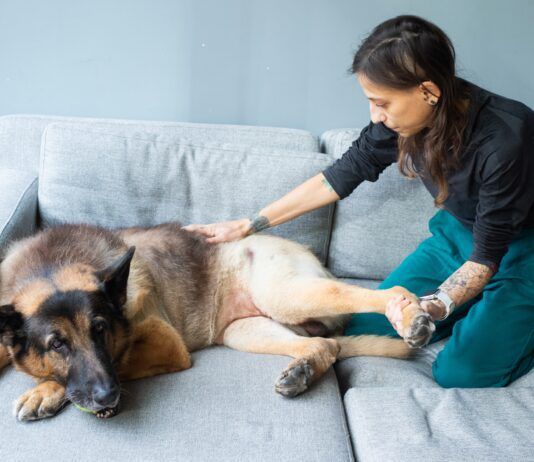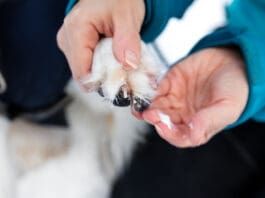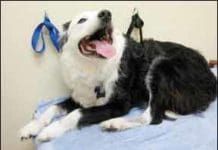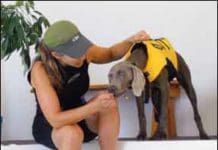Consider Light Therapy For Your Dog’s Rehab
One look at the x-rays of my Border Collie’s phalanges make many people cringe and say “Ouch!” Those visible boney growths on his toes have been confirmed by biopsy as osteoarthritis. This disease is present in both of his front paws and his pain is evident after too much exercise. My friends with arthritis describe their pain as often being excruciating and so when Duncan shows pain, I can only imagine what he must be feeling. At 11½, Duncan – a.k.a. “Dutaro” – can still snag a ball like the San Francisco Giant’s second baseman and never wants the game to end. In an effort to keep him as pain-free as possible, and thus active, healthy and happy, I incorporated laser therapy into his treatment program. Playing ball is in his blood; by adding the effects of laser therapy, he’s able to stay off the disabled list.
Veterinary Applications of Laser Therapy
Acupuncture Points and Trigger Points: Traditional Chinese acupuncture points are stimulated by a focused laser beam, used solely or in combination with acupuncture needles, to produce a systemic effect; high doses of laser therapy may be used to deactivate trigger points (hyperirritable spots that induce pain elsewhere in the body) found in muscle, ligaments, tendons, and periosteum.
Rolled-Up Welcome Mat?
No good deed goes unpunished. That’s what Pam Rowley of Upper Brookville, New York, discovered last November, when the hospital administrator who always greeted her and 8-year-old Vizsla Gunner at the start of their monthly therapy-dog visits quietly took her aside to deliver some bad news.
Plant Oils for Dogs
There are many different types of plant oils that people use to supplement their dogs’ diets, including oils from flaxseed, olives, coconut, vegetables, hempseed, and more. Some of these oils can provide benefits, but others are not helpful and may even contribute to inflammation.
Proteolytic Enzymes – Natural Pain Relief for Dogs
Enzymes given with food are used for digestion, but certain enzymes (proteases, which break down proteins) can also help with inflammation, pain, recovery from injury, and more when given apart from food. Systemic enzyme therapy, also called metabolic or proteolytic enzyme therapy, allows enzymes to enter the body where they can be used for healing rather than digestion. Examples of proteolytic enzymes include pancreatin, trypsin, and chymotrypsin (from the pancreas); bromelain (from pineapple); and papain (from papaya).
Roses Have Holistic Value for Dogs
Gertrude Stein might have thought that a rose is a rose is a rose, but with over a hundred species and more than a thousand named cultivars, the genus Rosa has been among the world's most appreciated plants for millennia. And they can be appreciated by dogs, too, with numerous applications for medical, emotional, and behavioral afflictions. Roses grow, with and without thorns, as compact or miniature varieties, trailing vines, climbing plants over 20 feet tall, and impenetrable shrubs. Their flowers range from large to small in white, pink, yellow, orange, and every shade of red. Most roses are native to Asia, while some originated in Europe, Africa, or North America.
Consider a Holistic Approach to Your Dog’s Health
Developing a holistic approach to your dog's health is a process
a process of self-discovery on your part, leavened with lots of trial and error. The real meaning of holistic dog care
Traditional Chinese Medical View on Dog Panting
From a Traditional Chinese Medicine (TCM) perspective, any medical condition is a symptom of an underlying disharmony within the body. This imbalance can be viewed through the yin and yang model, the base of TCM theory. Both exist within the body at all times. Yin represents the concepts of cooling, fluids, quietness, and passive behavior. Yang represents the concepts of heat, inflammation, outward energy, and aggressive behavior.
The Benefits of Apple Cider Vinegar to Dogs
People have been using vinegar for thousands of years, and while most of it goes into salads and condiments, vinegar can be used as a household cleanser, cosmetic aid, and health treatment. Many dog lovers add vinegar to their pets' food or apply it topically to their best friends. Advocates call vinegar, especially unpasteurized organic apple cider vinegar, a wonder food. Is vinegar really a health-improving supplement, a natural preservative, a nontoxic cleaning product, a disinfectant, a source of important nutrients, and an effective topical treatment for canine ailments?
Canine Hydrotherapists
Two schools in the United States (the University of Tennessee and the Canine Rehabilitation Institute) offer certification to veterinarians, physical therapists, veterinary technicians, and physical therapy assistants in canine rehabilitation. Courses include canine anatomy and physiology; conditions and injuries commonly referred for rehabilitation; physical modalities and their application, contraindications, and equipment maintenance; therapeutic exercise; client education; sports medicine; and hydrotherapy.
The Benefits of Hydrotherapy for Your Dog
Hampton was a dependable flyball dog. The underwater treadmill increased his strength and stamina for the sport.üGracie the Dalmatian lives in Great Falls
The Tellington TTouch For Dogs
of Berkeley
















